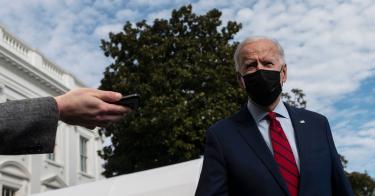Congress is racing to pass a $1.9 trillion legislative package, with the COVID-19 pandemic and the related economic slowdown as supposed justifications. However, the reasoning behind pushing such a massive amount of spending is badly flawed.
Reason #1: Health and economic trends are positive.
The efforts of the medical community to produce, distribute and administer vaccines are delivering tremendous results. According to the COVID Tracking Project, hospitalizations for COVID-19 are down 59% in the last seven weeks, and new cases are dropping faster.
This doesn’t mean the battle against COVID-19 is over. However, better tools are available than when the pandemic started, such as rapid self-tests to equip Americans to know their infection status—and we need the FDA to get out of the way.
Similarly, while the economy is not strong, it’s in better condition than during the Great Recession.
>>> 8 Things You Must Know About Deeply Flawed COVID-19 Package
The unemployment rate peaked at 14.8% in April 2020. Businesses adjusted and bounced back, and unemployment dropped to 6.3% in January 2021. While this is above the levels seen before the pandemic, it is hardly a crisis. For comparison, unemployment was above 6.3% from October 2008 through March 2014.
These positive trends point to COVID-19 and economic recovery as challenges to overcome, rather than crises requiring a huge amount of spending.
Reason #2: Enacted relief spending is enough for the economy.
Congress has already passed over $4 trillion to address the pandemic and the recession, or $32,500 per household. This includes public health activity, expanded unemployment and welfare benefits, individual checks, loan programs, handouts for a variety of industries, funds for state and local governments, aid to schools and more.
According to the Committee for a Responsible Federal Budget’s spending tracker, over $1 trillion of unspent relief funds are still available. Further, some aid is still in the process of being administered and distributed, including roughly $50 billion dedicated to reopening schools.
With unemployment falling, there is no need to spend even more on the economy, especially when so much is still available.
Reason #3: Sprawling legislative packages are stuffed with waste and opportunism.
Large bills seen in Congress as “must-pass” become a target for legislators’ pet projects. By attaching unrelated text as a “rider,” members can use a crisis to enact policies that would struggle on their own.
This has happened again with the new COVID-19 package. Provisions that have nothing to do with the pandemic or the recession, such as a bailout for private union pensions and a job-killing minimum wage hike, are included.
Similarly, spending that is wasteful to the general public but benefits political constituencies is always a part of such deals. For example, the current package includes a $90 billion bailout for pension plans covering private-sector union workers, an issue that has nothing whatsoever to do with the pandemic. This is pure political opportunism.
Reason #4: Federal “stimulus” spending is ineffective.
History shows that government “stimulus” spending has a terrible return on investment.
In the case of the $1.9 trillion package, none of the major provisions (apart from the 6% dedicated to battling the pandemic) would provide a sustainable economic benefit.
For example, the package includes $129 billion for K-12 schools, of which only 5% will be spent by September 30, according to the Congressional Budget Office. Amazingly, more will be spent in 2025 than 2021. How will that help reopen schools this fall or stimulate the economy during the crisis?
Increased welfare benefits discourage work. Welfare needs reform; expanding benefits and eliminating work requirements while allowing anti-marriage penalties will not truly help the poor. Blanket checks to individuals have led to spikes in savings and debt repayments rather than spending sprees. Hundreds of billions in handouts to state and local government entities would not boost the private sector activity that we depend on to improve our standard of living.
Reason #5: National debt is already dangerously high.
The total national debt currently stands at $27.9 trillion, or over $227,000 per household. This is the highest level relative to the economy during peacetime in the nation’s history, and it is poised to increase by more than $1 trillion per year for the foreseeable future.
It is irresponsible to risk our future financial health on the assumption that interest rates on federal debt will remain low forever. Even Larry Summers, President Obama’s Chairman of the National Economic Council, has expressed fears about this package being too big and hurting the economy.
Legislators should be cautious rather than reckless when it comes to considering new spending measures. When it comes to the $1.9 trillion spending package, the supposed remedy could end up being worse than the disease.
This piece originally appeared in the Daily Caller



